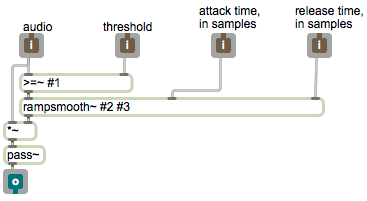[This example has been determined faulty and is thus deprecated by its author. It’s left here merely for reference, but will not produce optimal results in actual use. A better ducker~ is presented as an example for Music 215B, winter 2016.]
A “ducker” is a system that turns a signal down to 0 when it’s below a given threshold. It’s useful for suppressing unwanted low-level audio, such as in a cell phone transmission when the user is not talking. Or, more to the point for musical purposes, as in a microphone signal when the musician is not playing.
In this patch the user specifies an amplitude threshold, attack time, and release time, either by sending those values in the appropriate inlets or by typing them in as arguments to the object in the main patch.
When the amplitude of the signal coming in the left inlet goes above the threshold, the >=~ object sends out 1, so the rampsmooth~ object starts heading toward 1 in the number of samples specified (i.e., starts fading in the signal). So as not to lose too much of the wanted signal, that fade-in should be quick. A good attack time might be in the range of 5-40 ms, depending on the source. When the amplitude of the signal coming in the left inlet goes below the threshold, the >=~ object sends out 0, so the rampsmooth~ object starts heading toward 0 in the number of samples specified (i.e., starts fading out the signal). For many instruments, the release time might be slower than the attack time, so you might want that fade-out time to be longer than the fade-in time. A good release time might be in the range of 200 ms or more, depending on the source. In the main patch you can use the mstosamps~ object to calculate the correct number of samples for the fade times.

